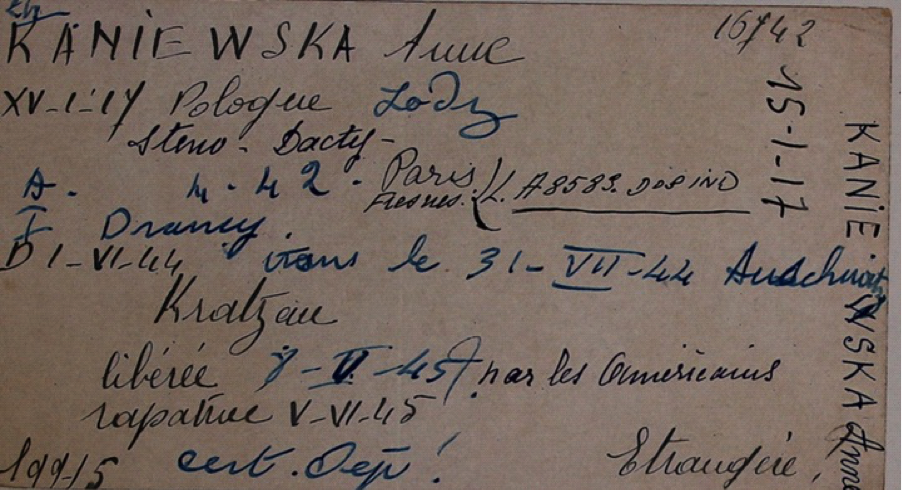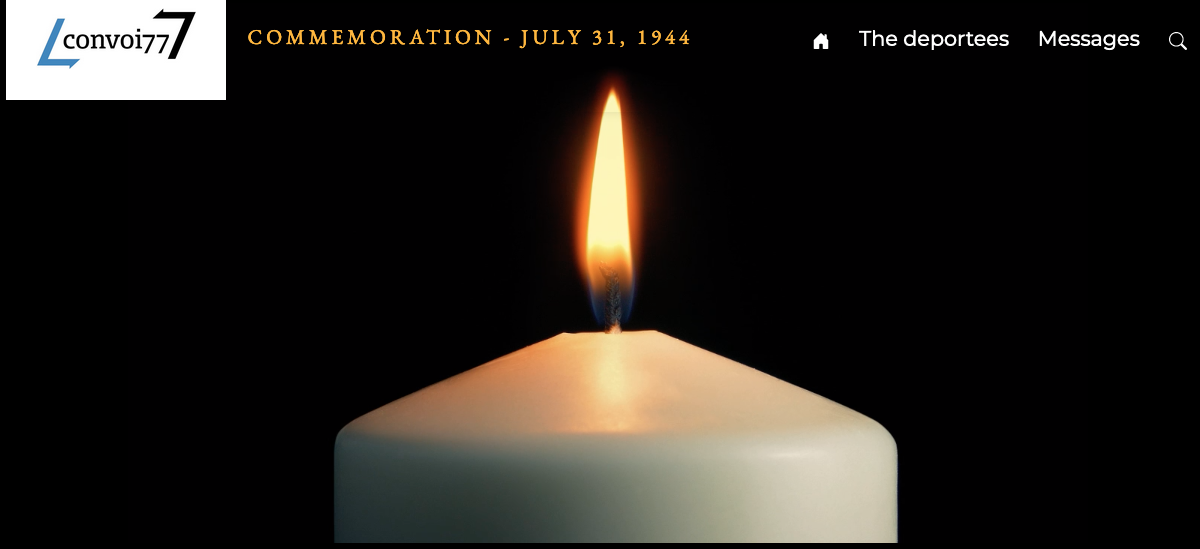Anna KANIEWSKA (1917-?)
Writing the life stories of people who were deported can sometimes be a difficult task, rather like piecing together a jigsaw puzzle. The French Historical Defense Service in Caen, in the Normandy region of France, holds individual files on many deported Jews, but not for Anna. The only record of her time in the concentration camps is one single card that lists her movements.
Anna Kaniewska’s deportation record, which summarizes her journey through the concentration camps. Source: Victims of Contemporary Conflicts Archives Division of the French Ministry of Defense Historical Service, in Caen, Normandy.
After the war, Anna chose not to testify about what she went through in the camps. It appears that she tried to fade into obscurity. As for photos of her, there are none. The records simply state that her name was Anna Kaniewska, that she was 5’1″ tall and had light blonde hair and a round face. In order to piece together what happened to her, we had to trace her journey through the concentration camps step by step and search through the archives. Little by little, doors began to open, enabling us to piece together her story.
Anna Kaniewska was born in Lodz, in Poland, on January 15, 1917. Her parents were Wolf Kaniewska and Marie Oligacz[1]. The records reveal very little about her childhood, but Anna appears to have attended school in Poland before going on to study medicine, as did her older brother, Jacques[2].
Anna must have left Poland soon after the German invasion on September 1, 1939, as she arrived in France on September 26. According to her information sheet from the immigration office, she was living at 18 rue Jeanne d’Arc in Saint-Mandé in what is now the Val-de-Marne department of France, and was not working at the time [3]. After the Germans invaded France, Anna left the Paris area and moved to the Oise department, where her brother, Jacques Kaniewski, who was a doctor, had his office at 29 rue du Marché in Cuise-la-Motte[4] . Soon after the first anti-Semitic legislation was passed in the Occupied Zone, all Jews had to take part in a census. On September 27, 1940, Anna registered herself as a doctor Cuise-la-Motte[5].
On August 16, 1940, the Vichy government passed a decree that banned Jews from working in certain professions, one of which was medicine. This included foreign Jews, Jews who had acquired French citizenship after 1927 and Jews born in France to a foreign father. As a result, few months later, Anna was struck off the medical register. Having been stripped of her right to work as a doctor, she found a job as a shorthand-typist. In other words, “She went from being in the socio-professional category of independent professional to that of employee, due to the discriminatory Vichy law against the Jews.”[6].
Later, probably because she was unable to find work, Anna appears to have left the Oise department and moved back to the Paris area. On February 21, 1942, the police arrested her for the first time, on suspicion of theft[7]. By order of the Paris Police Chief, she was detained temporarily in the Petite Roquette prison in Paris, where she was assigned the registration number 23124. Her prison record states that she had no fixed address and that she was Jewish. On February 23, Anna was tried by the criminal court in the 16th district of Paris. She was found guilty of theft and given a three-month suspended prison sentence. She was released on February 24, 1942[8].
On April 17, 1942, Anna was arrested again, this time by the German authorties[9]. She was sent to the la Santé prison later the same day. A German court sentenced her to six months and two weeks in prison for fraud. She should therefore have been released on October 30, 1942, at 5 p.m. However, the prison register states that the Gruppe Geheime Feldpolizei 61 (the German secret police) requested that: “on completion of her sentence, she be placed in the hands of the Santé prison authorities in order to be interned in a Jewish camp.” In the end, however, on April 30, 1942, Anna was transferred from the la Santé prison to the Haut-Clos prison in Troyes, in the Aube department of France[10]. Her prison record states that, “Anna should have been handed over to the Befehl der Sicherheitspolizei (BDS) in Paris (SIPO-SD) on Avenue Foch, following a decision made on July 30, 1942”. This transfer should therefore have been only temporary, but on August 14, 1942, Anna was hospitalized for eight months on health grounds, although the records do not provide any details. She was discharged from hospital on June 16, 1943, and temporarily sent back to the Haut Clos prison.
Her arrest record states that she was then transferred to the prison in Châlons-sur-Marne (now Châlons-en-Champagne), in the Marne department of France, on July 19, 1943. How long she stayed in Châlons-sur-Marne is unclear, as the Marne departmental archives have no record of her name in the prison registers. However, we know for certain that on June 30, 1944, Anna was transferred to Drancy camp, where she was searched and registered on arrival[11]. She remained in Drancy for four weeks, after which she was deported to Auschwitz on Convoy 77 on July 31, 1944.
When she arrived in Auschwitz, Anna was one of the 222 women on the convoy who were selected to enter the camp to carry out forced labor. They were tattooed with registration numbers A-8508 to A-8730: Anna’s number was A-8589. It would seem that Anna only stayed in Auschwitz for a few months, as according to her concentration camp record, she was transferred to the Kratzau camp in Czechoslovakia[12]. Although the exact date is not listed, she was probably transferred to Kratzau on October 27, 1944, at the same time as some of the other women from Convoy No. 77. In her testimony, Yvette Lévy, another Convoy 77 survivor, said “On October 27, 1944, after the terrible Dr. Mengele carried out a selection, I left Birkenau along with hundred or so other women, bound for the Union Werk in Kratzau, a small camp in Czechoslovakia that held about 1,000 people”[13]. This hypothesis is backed up by the Auschwitzer Kalendarium (Auschwitz Calendar) entry dated October 27, 1944, which states that 497 Jewish women were transferred from KL Auschwitz II transit camp to another concentration camp.
In Kratzau, the women initially worked in an armaments factory where they made parts for pistols and rifles. They were then given the task of making “nozzles, a kind of pipe that was filled with gunpowder and used on the V1 and V2 rockets.”[14]. Yvette Lévy’s testimony provides a glimpse into Anna’s daily life in the camp: “The work was very hard: I worked day shifts one week and night shifts the next, 12 hours a day, not counting the hour-long walk to and from the camp each morning and evening. Then there was the time spent at the roll call, and it was only after roll call that we were finally given our bowl of soup and could go to bed, if, and only if, we weren’t being punished.”[15]. After enduring more than six months of misery, Anna was liberated by the Russian army on May 8, 1945, and repatriated to France on June 5, 1945. There is no further trace of Anna in the post-war archives. Her name is inscribed on the Wall of Names at the Shoah Memorial in Paris, on slab No. 20, column No. 7, row No. 2.
Notes & references
[1] Anna Kaniewska’s prison record from the Haut-Clos prison register, Aube departmental archives
[2] According to various sources, Anna was able to read and write. She was also listed as a doctor in the census in the Oise department on September 27, 1940, which implies that she had studied medicine in Poland. Her brother Jacques came to France to complete medical school. He was naturalized as a French citizen in 1939.
[3] File on Anna Kaniewska, dated September 26, 1939, compiled by the police foreigners’ office, Paris Police Headquarters archives.
[4] Jacques Kaniewski’s naturalization application, available online on the French National archives website.
[5] Letter from the Prefect of the Oise department to the Chief of Police in Paris regarding Anna Kaniewska, French National archives, ref. AJ/ 38 / 4905
[6] Anaëlle Riou. Une micro-histoire de la Shoah en France. La déportation des Juifs du convoi 77. (A micro-history of the Holocaust in France. The deportation of Jews on Convoy 77), 2019. ⟨dumas-04071752⟩
[7] Anna Kaniewska’s prison record from Petite Roquette prison, entry dated February 21, 1942, Paris Archives, ref. 1443 W 32
[8] Ibid.
[9] Anna Kaniewska’s prison record from the Haut-Clos prison register, Aube departmental archives
[10] Ibid.
[11] Anna Kaniewska’s search record from Drancy camp (30/06/1944), Drancy search log, Shoah Memorial archives
[12] Individual deportation record for Anna Kaniewska, which summarizes her journey through the concentration camps, Victims of Contemporary Conflicts Archives Division of the French Ministry of Defense Historical Service, in Caen.
[13] From the testimony of Yvette Lévy, Convoy 77 survivor, about her time in KL Kratzau in Czechoslovakia.
[14] Ibid.
[15] Ibid.


 Français
Français Polski
Polski











